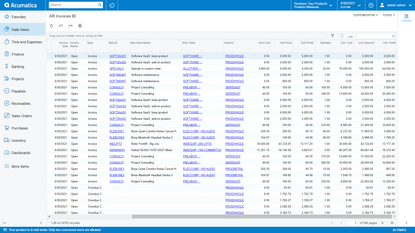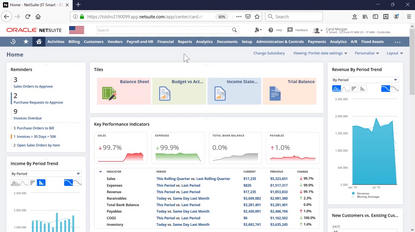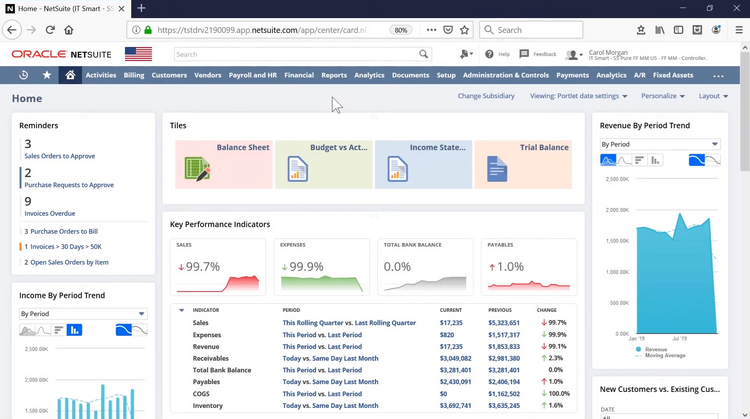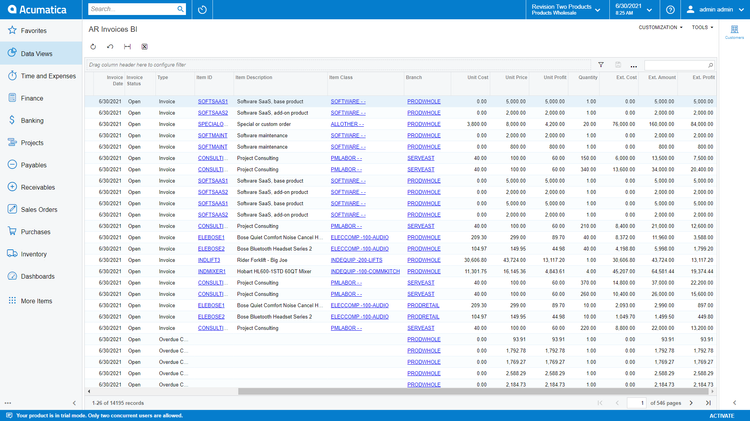Acumatica vs. NetSuite
Founded in 2008, Acumatica has quickly become one of the leading options on the market, thanks to its integrated approach to financial management, customer relationships, and project-based accounting. Meanwhile, NetSuite has been one of the leading cloud ERP software suites since the company was formed in 1998. Although both systems help companies around the globe increase productivity, they differ in numerous ways. Read on to compare these two ERP software.
NetSuite vs Acumatica: Quick Overview


NetSuite ERP is a cloud-based, developer-hosted, cloud ERP software platform offered on a software-as-a-service (SaaS) basis. It is designed for modern small businesses and midmarket companies that require cloud access and mobile-enabled tools. The system is designed to support growing organizations, letting users add or customize features as their company grows.
Oracle’s acquisition of NetSuite in 2016 has paved the way for NetSuite to be a stable and experienced cloud solution backed by a reputable multinational computer technology corporation. Due to this, Oracle–with their NetSuite offering–was recently listed as one of our top ERP vendors.

Acumatica cloud ERP system is designed for the SMB market. The software includes functionality for financial management, customer management, project accounting, distribution management, manufacturing management, field service management, and multi-channel order management. Compared to other ERP systems, Acumatica is extremely flexible in the features it can provide to its end-users. While Acumatica was designed and built for the cloud, it can also be deployed on-premise.

Features
Acumatica provides a range of integrated modules covering core business functions, including CRM, financial management, and inventory. The system also includes tailored modules for various industries, such as manufacturing, construction, and retail. It also features customizable reports, real-time dashboards, and BI tools for enhanced decision-making.
Key features of NetSuite include financial management, fixed assets, billing and invoicing, and inventory management. The solution aims to improve employee productivity via software automation and cross-departmental system integration.
These goals are accomplished through real-time data visibility, which facilitates better business decision-making, reduces technology support costs via outsourced application hosting, and eliminates dedicated server hardware investment costs.
Here is a functionality list for both Acumatica and NetSuite.
| Functionality | Acumatica Support | NetSuite Support |
|---|---|---|
| Accounts Payable | Yes | Yes |
| Accounts Receivable | Yes | Yes |
| Equipment Management | Yes | No |
| Bank Reconciliation | Yes | Yes |
| Benefits Management | No | Additional |
| Bill of Materials | Yes - Native | Yes |
| Billing | Yes | Yes |
| Budgeting | Some | Yes |
| Business Intelligence | Yes | No |
| Cash Flow Management | Yes | Yes |
| Commissions Management | Yes | Yes |
| Credit Card Processing | Yes | Yes |
| Customer Relationship Management | Yes | Additional |
| eCommerce | No | Additional |
| EDI | Yes | No |
| Employee Records | No | Yes |
| Estimating | No | Yes |
| Field Service Management | Yes | No |
| Fixed Asset Tracking | Yes | Yes |
| Fund Accounting | No | Yes |
| Fundraising Management | No | Yes |
| General Ledger | Yes | Yes |
| Human Resources | Yes | Yes |
| Inventory Control | Yes | Yes |
| Job Costing | Yes | Yes |
| Manufacturing Execution System | No | Yes |
| Material Requirements Planning | Yes | Yes |
| Payroll | Yes | Yes |
| Point of Sale | No | Additional |
| Project Management | Yes | Additional |
| Purchasing | Yes | Yes |
| Quotes | Yes | Yes |
| Recruitment and Talent Management | No | Additional |
| Sales Forecasting | Yes | Additional |
| Sales Order Management | Yes | Yes |
| Time Tracking | No | Yes |
| Warehouse Management (Advanced) | Yes | Yes |
| Work Order Management | Yes | Yes |
Pricing Model
Acumatica can be sold modularly with a “pay for what you use” approach. This means businesses can start small and expand their software suite as they grow or require more features or users (and pay a higher price accordingly). NetSuite, on the other hand, has a more standard pricing model, where the third parties that sell it have straightforward costs for a complete package.
Pricing for Acumatica depends on a variety of factors, including selected module suits, deployment preference (internal/SaaS), bandwidth/storage (SaaS only), and implementation and support requirements. However, unlike many other ERP solutions, user count does not affect Acumatica pricing, as Acumatica licenses support unlimited users.
Pricing for NetSuite varies depending on user count, support expectations, module selections, implementation needs, and other factors. The cost of NetSuite will generally start at $129/user/month, which includes a 10-user minimum. This usually comes with an annual contract. Additional setup fees include implementation, integrations, customizations, and data migration.
Deployment Options
Acumatica can be deployed in the cloud or on-premise. However, Acumatica strongly encourages users and resellers to use/sell the cloud option.
Benefits of deploying Acumatica in the cloud include:
- Avoiding stagnation: Frequent updates are available, and teams can easily add users to their platform.
- Mobility: Allow access from multiple locations via web browsers or use mobile apps for various functions.
- Avoid downtime during updates: While updates are available for on-premise software, they are usually conducted less frequently than a continuously updated cloud system. Because of this, updating a legacy system can be a slow and painful process, leading to expensive charges or downtime that affects your bottom line.
NetSuite is a true cloud SaaS solution. When NetSuite was originally developed in 1998, it was to be a web-based accounting system. Since 2008, NetSuite has acquired several companies in eCommerce, professional services, and manufacturing to bolster the functionalities it can offer in the cloud.
